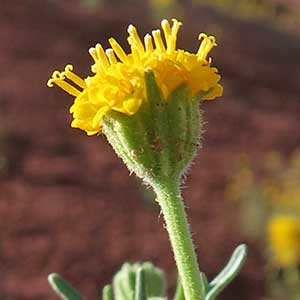Chaenactis nevii
Chaenactis stevioides
John Day pincushion, John Day's pincushion, Nevius' chaenactis
broad-flower chaenactis, desert or Esteve or broad-flower pincushion, desert pincushion, Esteve pincushion, Esteve's pincushion, Steve's dustymaiden
mostly 1–3;
branches mainly distal.
1–12 (sometimes decumbent);
branches proximal and/or distal.
basal (withering) and cauline, 2–5 cm;
largest blades ± elliptic, ± plane to 3-dimensional, not succulent, 1–2-pinnately lobed;
primary lobes mostly 3–8 pairs, ± remote, ultimate lobes ± plane to involute.
basal (usually withering) and ± cauline, 1–8(–10) cm;
largest blades ± elliptic, ± 3-dimensional, usually not succulent, mostly 1–2-pinnately lobed;
primary lobes 4–8 pairs, remote or ± congested, ultimate lobes ± involute and/or twisted.
1–6 cm, distally stipitate-glandular and, sometimes, ± arachnoid to villous.
1–5(–10) cm, usually stipitate-glandular distally and, often, ± arachnoid.
± hemispheric to campanulate.
± hemispheric to obconic (bases green, rounded in fruit).
corollas bright yellow, 4–6.5 mm;
peripheral corollas ± erect, actinomorphic, scarcely enlarged.
corollas white to pinkish, cream, or pale yellow, 4.5–6.5 mm (inner);
peripheral corollas spreading, zygomorphic, enlarged.
longest 6–9 mm;
outer predominantly stipitate-glandular and, sometimes, ± arachnoid to villous in fruit, apices ± erect, acute, rigid.
longest 5.5–8(–10) mm;
outer stipitate-glandular and/or ± arachnoid in fruit, apices erect, blunt, ± rigid.
mostly 3–9 per stem.
(± radiant) mostly 3–20+ per stem.
3.5–6 mm (compressed);
pappi 0 or coroniform (of ± 10 scales, longest 0.1–0.5 mm).
(3–)4–6.5 mm;
pappi of (1–)4(–5) scales, usually in 1 series, rarely with partial outer, abruptly unequal series, longest scales 1.5–6 mm, lengths mostly 0.3–0.9 times corollas (apices hidden among corollas at flowering).
= 12.
= 10.
Chaenactis nevii
Chaenactis stevioides
Chaenactis nevii is known from the John Day Basin area in Gilliam, Grant, Jefferson, Wasco, and Wheeler counties. This odd and isolated species combines traits of C. artemisiifolia (sect. Acarphaea) and C. glabriuscula, and might be descended from their common ancestor.
(Discussion copyrighted by Flora of North America; reprinted with permission.)
Chaenactis stevioides is found throughout the southwestern deserts; it is among the most abundant spring wildflowers in the higher Mojave Desert and southern Great Basin. It also extends seaward into west-central California. It has been reported in New York as a garden escape; it is not expected to persist there outside cultivation.
Chaenactis stevioides varies in more or less concentric zones. Plants from the core zone (centered on the Great Basin and Mojave Desert) typically have pappi and phyllaries relatively short and phyllaries predominantly stipitate-glandular (var. brachypappa). Surrounding this zone to the southwest, southeast, and northeast are plants with pappi and phyllaries relatively long and phyllaries evidently or predominantly lanuginose (var. stevioides). Scattered on the periphery in central Arizona, Baja California, and west-central and southwestern California (where hybrids may be involved; see sectional discussion) are mesophytic forms with relatively long and/or broad leaf divisions, corollas varying from white to pale yellow, and pappi and phyllaries like those of var. brachypappa (var. thornberi, C. gillespiei). An unnamed form with leaves arachnoid but otherwise like C. fremontii occurs around sand dunes in the Mojave Desert. Chaenactis furcata and C. latifolia are forms possibly influenced by C. fremontii genes, unusual substrates, or pathogens. Traits of all the above taxa are inconsistent within populations, and/or recurrent or recombinant elsewhere in the range of C. stevioides.
(Discussion copyrighted by Flora of North America; reprinted with permission.)


